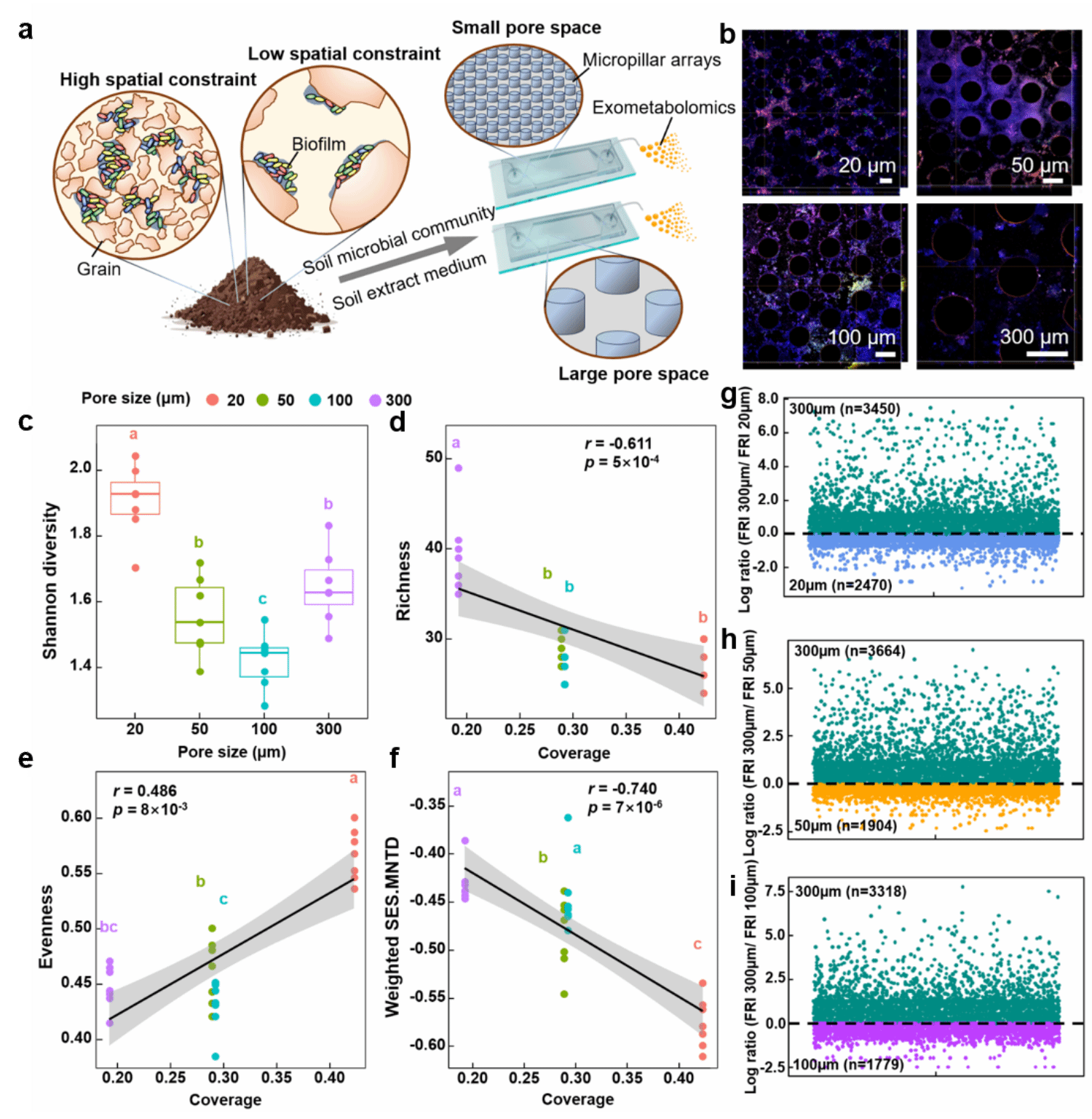南湖新闻网讯(通讯员 吴一超 付承霞)近日,我校农业微生物资源发掘与利用全国重点实验室、资源与环境学院蔡鹏教授领衔的土壤生物膜与环境健康团队在Microbiome在线发表了题为“The mitigation of spatial constraint in porous environments enhances biofilm phylogenetic and functional diversity”的研究论文。该研究通过整合土壤微流控芯片与多组学技术,揭示了多孔环境的物理结构在塑造生物膜群落结构、调控组装过程和促进功能多样性方面的关键作用,为环境、工业及医学领域中有效调控微生物群落与功能提供了新见解。
生物膜(Biofilm)是由微生物细胞及其分泌的胞外聚合物(EPS)相互粘结形成的多细胞聚集体,代表了微生物在自然环境中的主要生存形态。土壤和沉积物等孔隙环境作为地球上90%以上微生物的栖息地,其物理结构在塑造生物膜群落中扮演着关键角色。目前的研究主要通过环境采样和颗粒物粒度分类来研究孔隙物理结构对生物膜群落的影响。然而,环境样品中的孔隙结构变化往往伴随着养分含量、化学性质、固相界面等多种因素的同时变化,这使得难以准确量化孔隙结构对生物膜群落结构的独立影响。
为克服上述挑战,研究团队采用含不同尺寸微柱阵列的土壤微流控芯片培养土壤生物膜菌群,并结合激光共聚焦显微镜、扩增子测序和代谢组学,系统研究了孔隙结构对土壤生物膜群落组装的影响(图1)。研究结果显示,相较于小尺寸孔隙环境,生物膜在较大孔隙空间中定殖后展现出更高的厚度和粗糙度。随着孔隙空间的增大,生物膜群落的系统发育多样性显著提升,同时确定性过程在群落组装中的影响逐步增强。对微流控芯片流出液的胞外代谢物分析表明,生物膜的代谢功能与群落结构呈现显著相关性,且大孔隙空间中群落丰富度的增加与胞外代谢物多样性的显著提升密切关联。该研究揭示了缓解多孔环境对生物膜生长的空间限制有助于促进形成具有更高系统发育和功能多样性的生物膜,为调控孔隙环境中的生物膜群落提供了重要科学依据。

图1. 不同空间限制条件下土壤生物膜群落的多样性和功能特性
华中农业大学资源与环境学院博士研究生付承霞为第一作者,吴一超副研究员为论文通讯作者。华中农业大学蔡鹏教授、黄巧云教授、高春辉副研究员、渠晨晨副教授、戴珂副教授、博士后张铭、丹麦哥本哈根大学Søren J. Sørensen教授等参与了该项研究工作。此项研究获得了国家自然科学基金等项目的资助。
审核人 蔡鹏
【英文摘要】
Porous environments constitute ubiquitous microbial habitats across natural, engineered, and medical settings, offering extensive internal surfaces for biofilm development. While the physical structure of the porous environment is known to shape the spatial organization of biofilm inhabitants and their interspecific interactions, its influence on biofilm community structure and functional diversity remains largely unknown. This study employed microfluidic chips with varying micropillar diameters to create distinct pore spaces that impose different levels of spatial constraints on biofilm development. The impact of pore spaces on biofilm architecture, community assembly, and metabolic functions was investigated through in situ visualization and multi-omics technologies.
Larger pore sizes were found to increase biofilm thickness and roughness while decreasing biofilm coverage over pore spaces. An increase in pore size resulted in reduced biofilm community evenness and increased phylogenetic diversity. Remarkably, biofilms in 300-μm pore spaces displayed the highest richness and the most complex and interconnected co-occurrence network pattern. The neutral model analysis demonstrated that biofilm assembly within different pore spaces was predominantly governed by stochastic processes, while deterministic processes became more influential as pore space increased. Exometabolomic analyses of effluents from the microfluidic chips further elucidated a significant correlation between the exometabolite profiles and biofilm community structure. The increased community richness in the 300-μm pore space was associated with the significantly higher exometabolome diversity.
Collectively, our results indicate that increased pore space, which alleviated spatial constraints on biofilm development, resulted in the formation of thicker biofilms with enhanced phylogenetic and functional diversity.
论文链接:https://doi.org/10.1186/s40168-025-02075-0